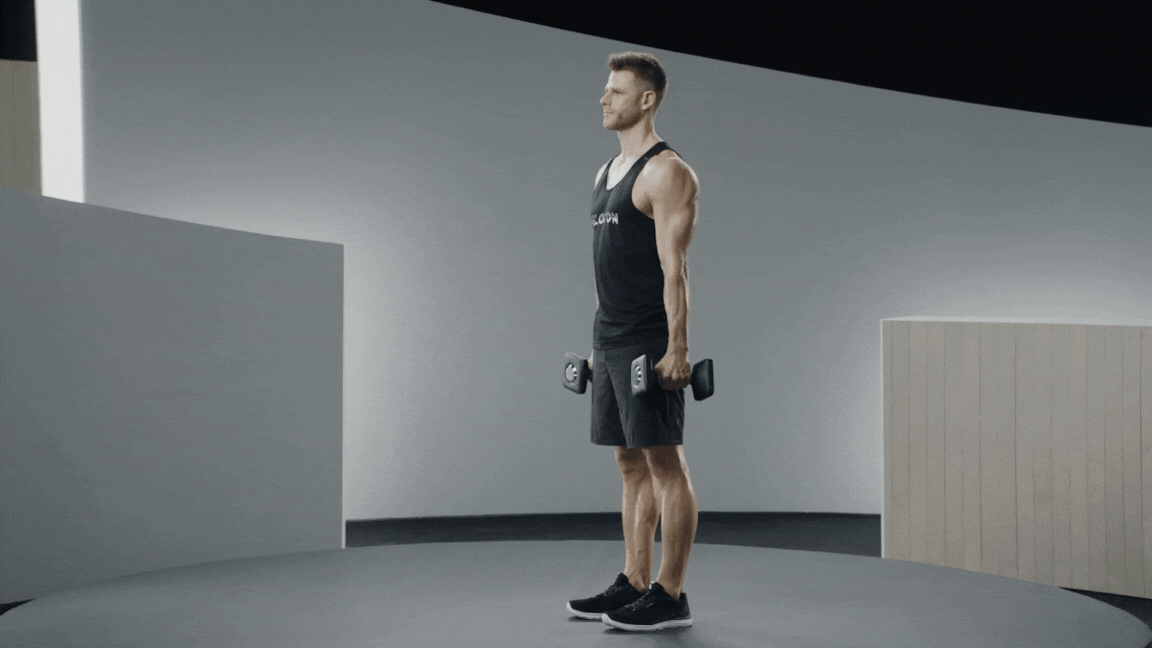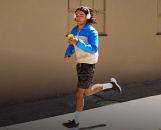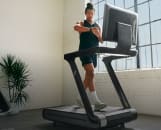
LaylaBird/E+ via Getty Images
12 Forearm Exercises for Stronger Arms and Better Grip Strength
Grip strength is an important, yet overlooked indicator of longevity—here’s why.
By Emily Laurence•
What Are the Forearm Muscles?
What Are the Benefits of Doing Forearm Strength Exercises?
12 Forearm Workout Moves for Stronger Arms and Grip Strength
Common Mistakes to Avoid When Doing Forearm Workouts
How and When to Add Forearm Exercises to Your Workout Routine
You’ve probably already heard that the benefits of upper body strength training go way beyond aesthetics. It’s key for maintaining muscle mass, keeping bones strong, supporting good posture, and enabling you to perform everyday tasks (such as lugging heavy groceries from the car) with ease.
But an effective upper body strength training routine doesn’t just focus on the shoulders, chest, and biceps. It’s important to do moves that target the forearms and require a firm grip too. Having strong forearms and a strong grip are important for everyday tasks, like opening jars, and for playing sports like tennis, pickleball, baseball, and golf.
Not sure where to start? Keep reading to learn more about why forearm strength matters, and score expert recommendations for forearm exercises you can add to your routine.
What Are the Forearm Muscles?
The forearms consist of 20 muscles—more than most people realize, explains Raquelle Felder, a doctor of physical therapy and owner of San Diego Mobile Rehab. “The different muscles are organized into two compartments: the anterior and posterior,” she says.
The anterior compartment is located on the palm side of the forearm and contains muscles that flex the hand and wrist—that is, they bend your wrist so your palm moves closer to your forearm, or your fingers move toward your palm (for example, making a fist), Felder explains. The anterior compartment also plays a role in rotating the forearm so that the palm faces down, known as pronation.
The posterior compartment is located on the other side of your forearm (think: the same side as the top of your hand). It houses the muscles that extend the wrist, meaning they move the top of the hand and fingers backward toward the forearm. This compartment also aids in supination, or rotating the forearm so the palm faces up. “Think of cupping your hands together in a bowl for soup,” Felder says—that’s supination.
Forearm muscles are crucial for many daily tasks. Gripping and carrying items, typing, writing, and using utensils all require the use of forearm muscles, Felder says.
What Are the Benefits of Doing Forearm Strength Exercises?
Peloton instructor Marcel Maurer emphasizes that forearm strength is important for everyone. “Regardless of sport, trained arms help us in everyday life, for example when carrying shopping bags or lifting objects,” he says.
If you do play sports or like to work out regularly, incorporating forearm exercises into your routine can help improve your performance and protect you from injury, Marcel says. “Trained arms help us perform sporting movements even more powerfully and explosively, and also relieve pressure on joints, making them less susceptible to injury,” he says.
One important benefit of doing forearm strength exercises regularly is that they help improve grip strength. “If you regularly grip and lift dumbbells, you will strengthen the forearms, which you need for grip strength,” Marcel explains.
Tanner Neuberger, a physical therapist and clinic manager at Athletico Physical Therapy, adds to this, saying that stronger forearms and stronger grip strength go (literally) hand-in-hand; when one gets stronger, so does the other. That’s because forearm muscles—namely the flexors—are the main muscles responsible for gripping things, along with the small muscles in your hands.

Peloton App
Access thousands of classes with no equipment needed.
The Importance of Grip Strength
Both Marcel and Neuberger explain that if you have weak grip strength, you won’t be able to do many arm exercises properly. It’s impossible to do a pull-up if you can’t hold on to the bar, for one.
“If you have weak grip strength, you will eventually no longer be able to grip dumbbells. Movements such as the bicep curl can no longer be performed at some point, not because the biceps are tired, but because the grip strength and forearms are no longer strong enough,” Marcel says.
Besides helping you out in the gym, you likely use your gripping skills more than you realize throughout the day. Picking up your kids, opening a heavy door, shoveling, and even using eating utensils all require sufficient grip strength.
There’s even some research suggesting that grip strength can serve as an powerful biomarker for overall health. For example, a 2024 research review published in the Journal of Health, Population and Nutrition found that weak grip strength is correlated with overall mortality risk and several diseases, including Type 2 diabetes, cardiovascular disease, stroke, chronic kidney and liver disease, some cancers, sarcopenia, and bone fractures. This doesn’t mean that building jacked forearms will automatically increase your lifespan or healthspan. Rather, it’s that grip strength often reflects a person's overall muscle mass and physical condition. Staying active in ways that build or maintain overall strength (including your forearms and grip) can play a role in the larger picture of your overall health.
12 Forearm Workout Moves for Stronger Arms and Grip Strength
If you’re wondering how to make your forearms bigger or increase both your forearm strength and grip strength, below are the exercises to integrate into your strength training routine.

1. Biceps Curl
This is one of Marcel’s go-to forearm exercises. In addition to strengthening the forearms and the biceps, biceps curls also help support elbow stability. If you’re new to biceps curls, over time, try working up from one to three sets.
Hold a dumbbell in one hand by your side, with your arm extended and palm facing forward.
Bend your elbow to lift the dumbbell up to your shoulder, keeping your elbow close to your body.
Pause when the dumbbell is in front of your shoulder, palm facing your body. Then, lower the dumbbell with control to return to the starting position.
Do 8–12 reps and then repeat on the other side. Do a total of 1–3 sets on each side.

2. Triceps Kickback
Another forearm exercise Marcel recommends is the triceps kickback, which not only strengthens forearms and triceps but also targets the core thanks to the forward hinge position.
Stand with a dumbbell in each hand, arms by your sides, with your palms facing inward. With your knees softly bent, hinge forward at the hips until your torso is at about 45 degrees, maintaining a neutral spine.
Bend your elbows and draw them backward to pull the weights up to your ribs so your elbows are bent at about 90 degrees. Keep your neck long and your gaze on the floor just in front of your feet. This is your starting position.
Straighten your arms to lift the weights behind you, squeezing your triceps at the top.
Reverse the movement to return to the starting position.
Do 3 sets of 8–12 reps.
3. Cable Wrist Curl
In general, Neuberger says wrist curls are a great way to increase grip strength and build isolated strength in your forearms. If you want your forearms to get bigger, he says cable wrist curls are an especially great move to do regularly. For this exercise, you’ll need access to a cable machine.
Place the anchor on the lowest setting. Connect a bar attachment to the hook on the end of the cable, and hold it with both hands, one on their side. Sit on a bench so the cable pulley is directly in front of you, centered between your legs.
Rest your elbows on your thighs with your palms facing up. Moving only your hands, curl the bar toward your forearms. Hold for two seconds at the top, then reverse the movement with control.
Do 3 sets of 8–12 reps.
4. Wrist Extension
Jasmine Marcus, a physical therapist at Cayuga Medical Center, explains that this wrist extension move helps strengthen the extensor muscles. If you play tennis, she says this is an especially beneficial exercise to do because it can help prevent tennis elbow. To increase the challenge, you can also hold a very light dumbbell (1-2 pounds) in your hand.
Rest your forearm on a table or the arm of a chair with the palm facing down, allowing your hand to hang off the front edge.
Bend your wrist upward to reach your fingertips toward the ceiling while keeping your forearm pressed down.
Hold for one count, then reverse the motion to lower your fingers toward the floor and return to start.
Do 8–12 reps, then repeat on the other side.
5. Wrist Flexion
This wrist exercise and stretch also comes recommended by Marcus because it helps strengthen the flexor muscles in the forearm’s anterior compartment. She says it’s a great move for golfers because it can help protect against golfer’s elbow. To make it harder, you can hold a very light dumbbell (1-2 pounds) in your hand.
Rest your forearm on a table or the arm of a chair with the palm facing up, allowing your hand to hang off the front edge.
Bend your wrist upward to reach your fingertips toward the ceiling while keeping your forearm pressed down.
Hold for one count, then reverse the motion to lower your fingers toward the floor and return to start.
Do 8–12 reps, then repeat on the other side.
6. Suitcase Carry
Another forearm exercise Neuberger recommends is the suitcase carry (aka a unilateral farmer’s carry). It strengthens your grip as well as your shoulders, abs, glutes, and legs, so it’s a great way to increase overall strength—not just in your forearms.
Hold a dumbbell or kettlebell in each hand.
Keeping your back straight, core engaged, and shoulders back, walk forward with controlled steps, similar to if you were carrying a suitcase in each hand.
Continue for 30–60 seconds.

7. Lateral Raise
Lateral raises, as recommended by Marcel, help increase grip strength while targeting the upper arms and shoulders.
Hold a dumbbell in each hand with your arms by your sides, your palms facing inward, and your feet shoulder-width distance apart.
Engage your core and lift your arms out to the sides, leading with your elbows, until the weights are at shoulder height.
Hold for two seconds at the top, then lower your arms down to your sides with control.
Do 3 sets of 8–12 reps.

8. Barbell High Pull
If you want to increase your power, high pulls are a great way to do so while also improving your grip strength. It’s a move Marcel recommends doing regularly for bigger, stronger forearms. You can do high pulls with a variety of equipment, including kettlebells, dumbbells, or barbells (as described here).
Place the barbell on the floor in front of you and stand with your feet hip-width distance apart. Engage your core, hinge at your hips, and bend your knees to grab the barbell slightly wider than shoulder-width apart, using an overhand grip with your palms facing your body.
Keeping your back straight, deadlift the bar up to a standing position, so the barbell is in front of your thighs with your arms extended. This is your starting position.
Maintain a straight back and an engaged core, and bend your knees into a quarter squat to lower the barbell to about knee height. Explosively push into the floor to straighten your legs, come up onto the balls of your feet, and pull the barbell up to shoulder height, drawing your elbows up and out to the sides.
With control, allow the barbell to fall back down to the starting position, keeping your knees softly bent.
Do 3 sets of 5–8 reps.

9. Zottman Curl
Marcel likes the Zottman curl, a variation of the biceps curl, as a way to build forearm and grip strength (in addition to stronger biceps).
Hold a dumbbell in each hand with your arms extended by your sides with your palms facing away from you.
Engage your core and bend your elbows to curl both dumbbells up to your shoulders.
When the weights reach your elbows, rotate your wrists to turn the weights so your palms are facing forward.
Maintaining this grip, lower the dumbbells until your arms are straight.
At the bottom of the movement, rotate your wrists so your palms face forward again, and you return to the starting position.
Do 3 sets of 8–12 reps.
10. Reverse Barbell Curl
“This exercise focuses on strengthening a major forearm muscle called brachioradialis,” Felder says. Every time you bring a glass to your mouth, for example, you’re using the brachioradialis muscle. “Additionally, this exercise improves forearm extensors, which strengthens all of the posterior compartment muscles,” Felder adds.
Pick up a barbell using an overhand grip (palms facing your body), placing your hands shoulder-width apart.
Curl the bar up to your shoulders while keeping your elbows tucked in at your sides.
Without pausing, lower the barbell with control to the starting position.
Do 3 sets of 8–12 reps.
11. Towel Wringing
You can use your gym towel for more than just sopping up your sweat; it can also be used to work your forearms. “This exercise is great for strengthening both wrist flexors and extensors in a functional way while also improving grip strength, endurance, and coordination,” Felder says.
Hold a sweat towel or hand towel horizontally in front of you, one hand on either end.
Twist each end of the towel in opposite directions, as if you were wringing out water.
Do 2 sets of 8–12 reps.
12. Stress Ball Squeezes
If you have a stress ball on hand, you have a tool you can use to increase your grip strength while you’re sitting at your desk or on the couch. Marcus says that doing this regularly will allow you to lift heavier weights as well as make functional tasks, such as opening jars, easier.
Hold the stress ball in one hand.
Squeeze the ball as tightly as you can for 5 seconds and then release.
Do 3 reps, then repeat on the other side.
Common Mistakes to Avoid When Doing Forearm Workouts
When doing the above forearm exercises, make sure you aren’t overextending your wrists, a common mistake many people make, Marcel says. While some forearm exercises do require extending the wrist, it’s important to avoid excessively bending it forward or backward beyond its natural range of motion. If you feel any pain, that’s a sign that you’re overextending or overflexing your wrists.
Additionally, Neuberger advises making sure you aren’t using dumbbells that are too heavy. Otherwise, you could injure your wrists or forearms. “Your dumbbells don’t need to be particularly heavy to do these movements for them to be effective,” he says. If you find yourself using your entire arm for exercise moves where you should only be using your forearms, Neuberger says this is a sign your weights are too heavy.
How and When to Add Forearm Exercises to Your Workout Routine
In terms of when and how often to do these forearm exercises, Neuberger says they can be integrated into your upper body strength routine a few times a week. Just make sure you’re allowing the muscles to rest and recover by staggering your upper body strength training days instead of doing them back-to-back.
Even if you’re regularly strength training using dumbbells, a pull-up bar, or other tools that require grip strength, Felder says that it can still be beneficial to do forearm-specific exercises regularly. “Yes, [these muscles] are used in various strength training exercises, but integrating the suggested exercises focuses more on the forearm muscles specifically that we use and rely on with daily tasks,” she says. She adds that while compound movements, such as pull-ups and dumbbell exercises, do engage the forearm muscles for strengthening, they may not sufficiently target the grip endurance and wrist stability needed in sports, labor jobs, and daily life tasks.
If you want to do forearm exercises the same day as a cardio workout, like a run or cycling session, Marcel recommends doing them before cardio, which is more effective for building muscle strength.
Remember, when you strengthen your forearms, you’re improving your grip strength at the same time, an important marker for longevity. Stronger bodies live longer than frail ones. So get lifting!
Related Articles

Strength Train
Grip Strength Isn’t Just For Pull-Ups—Here’s Why You Need It, Plus the Best Grip Strength Exercises to Try

Strength Train
The 6 Best Resistance Band Moves for a Strong Upper Body

Strength Train
6 Exercises to Try for the Best Barbell Workout

Strength Train
These 8 Strength Training Moves Are the MVPs for a Strong Upper Body
This content is for informational and educational purposes only and does not constitute individualized advice. It is not intended to replace professional medical evaluation, diagnosis, or treatment. Seek the advice of your physician for questions you may have regarding your health or a medical condition. If you are having a medical emergency, call your physician or 911 immediately.
Level up your inbox.
Subscribe for a weekly dose of fitness, plus the latest promos, launches, and events.
By providing your email address, you agree to receive marketing communications from Peloton.
For more about how we use your information, see our Privacy Policy.






